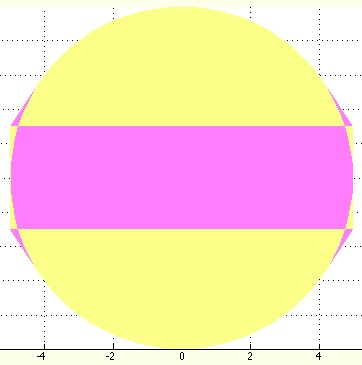PLELDelaunay
by Tim C. Lueth, SG-Lib Toolbox: SolidGeometry 5.6 - PLEL/Point List/Edge List
Introduced first in SolidGeometry 1.1, Creation date: 2013-12-28, Last change: 2025-09-14
return the Delaunay Triangulation
Description
This function is exactly the DelaunayTri without any modifications but different warnings are switched off
Example Illustration

Syntax
[PLN,ELN,FLall,in,FLin,FLout,warn]=PLELDelaunay(PL,EL)
Input Parameter
PL: | | Point list |
EL: | | Edge list |
Output Parameter
PLN: | | Point list could have changed |
ELN: | | edge list could have changed |
FLall: | | Delaunay triangulation |
in: | | inside/outside status |
FLin: | | FLall(in,:) |
FLout: | | FLall(~in,:) |
warn: | | last warn result |
Copyright 2013-2025 Tim C. Lueth. All rights reserved. The code is the property of Tim C. Lueth and may not be redistributed or modified without explicit written permission. This software may be used free of charge for academic research and teaching purposes only. Commercial use, redistribution, modification, or reverse engineering is strictly prohibited. Access to source code is restricted and granted only under specific agreements. For licensing inquiries or commercial use, please contact: Tim C. Lueth
Algorithm (Workflow)
This function, PLELDelaunay, is designed to perform Delaunay triangulation on a given set of points and edges. It is part of the SG-Library and was created by Tim Lueth. The function takes two input parameters and returns several outputs related to the triangulation process.
Input Parameters
- PL: Point list, which is a set of coordinates representing points in 2D space.
- EL: Edge list, which defines connections between the points in the point list.
Output Results
- PLN: Updated point list, which may have changed after the triangulation process.
- ELN: Updated edge list, which may have changed after the triangulation process.
- FLall: The complete Delaunay triangulation, represented as a list of facets.
- in: A status indicator showing whether facets are inside or outside.
- FLin: Facets that are inside, derived from FLall using the 'in' status.
- FLout: Facets that are outside, derived from FLall using the 'in' status.
- warn: The last warning message generated during the process.
Algorithm Steps
- Warnings related to Delaunay triangulation are temporarily turned off to avoid interruptions during the process.
- The DelaunayTri function is called with the point list (PL) and edge list (EL) to perform the triangulation. This function is specifically for 2D data.
- The last warning message is captured and stored in the variable 'warn'.
- Warnings are turned back on to their original state.
- The inOutStatus function is used to determine which facets are inside or outside, storing the result in the variable 'in'.
- The updated edge list (ELN) and point list (PLN) are extracted from the DelaunayTri object.
- All facets from the triangulation are stored in FLall.
- Inner facets are extracted using the 'in' status and stored in FLin.
- Outer facets are extracted using the 'in' status and stored in FLout.
Algorithm explaination created using ChatGPT on 2025-08-19 07:23. (Please note: No guarantee for the correctness of this explanation)
Last html export of this page out of FM database by TL: 2025-09-21